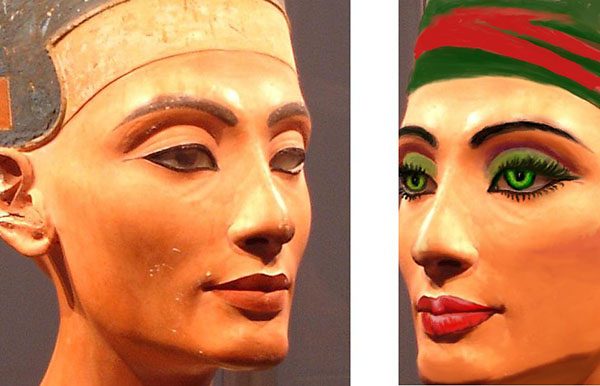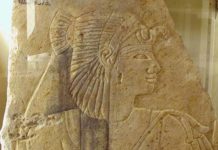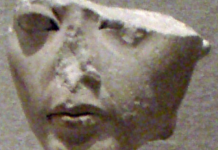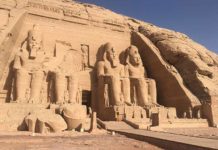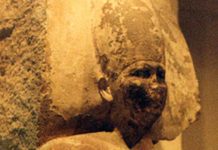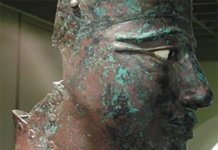Women in Ancient Egypt were fixated on cleanliness, makeup, and beauty. Ancient Egyptians were known for their distinct eye makeup, oils and perfumes.
Ancient Egyptians were fixated on cleanliness and beauty, and at the very least, eye makeup was used by men, women and children of all status. The main ingredient of the makeup was also used to combat eye inflammation and infection ever present in marshy swamps along the Nile and the dry, arid conditions beyond.
Ancient Egyptian Hygiene
Both men and women shaved and plucked all their body hair using tweezers, knives, and razors of flint and metal. Various oils were used as shaving lotions. Rich Egyptians shaved their heads and used wigs made of human hair which were worn every day. Whether or not the women also shaved their heads depended on the dynasty. Aside from being fashionable, wigs were worn to protect the scalp from the sun’s heat and prevent head lice common to the environment. Women who kept their hair used extensions to fill thinning areas, carefully woven and knotted to their own hair with beeswax and resin. Henna was the favorite tint used to cover premature gray – women of ancient Egypt had an average life span of forty. Perfumed oils were rubbed into the scalp after shampooing to scent the hair.
For soap when bathing, natron was used; a compound that occurs naturally in baking soda mixed with sodium carbonate, the latter extracted from the ashes of many plants and currently synthetically produced from table salt as a water softener. As far back as 1500 BC, soaps were also made from animal or vegetable oil and salt. Cleansing creams were a mixture of chalk and oil. The wealthy had bathing facilities in their homes, but the majority bathed in the Nile which was also used for laundry and sewage. Water born diseases were common. Queens of Ancient Egypt preferred to bathe in milk as it exfoliated and restored their skin. Linen towels were used for drying.
Undiluted, natron was also used as toothpaste (probably applied by finger) and mouthwash. They chewed parsley or similar herbs for fresh breath. Though the remains of Ancient Egyptians show little tooth decay, their teeth were much worn by the invasive granules of the sands.
Ancient Egyptian Makeup
For cosmetic and fragrance use, Egyptians preferred oil from the Balanites Aegyptiaca – a tree native to Africa and the Middle East, nuts of the Moringa or Horseradish tree, and almond oil. These oils had a pleasing aroma and were beneficial for dry or aging skin. Fenugreek seeds were used as a skin softener and for facial masks, and Ancient Egyptians believed that a tea made from these seeds could stimulate breast growth. Frankincense and myrrh were rubbed into the skin as aromatic protection against the harsh arid climate as well as to rid themselves of body lice. Aloe vera was treasured by Ancient Egyptian queens for smoothing skin. Natural honey was also used as a facial.
Both men and women outlined their eyes in green or black almond shapes with long tails in the outer corners. The green was made from malachite, an oxide of copper from Sinai. Green was eventually replaced with the black color of Galena – lead sulfide found near Aswan and the Red Sea Coast, combined with other ingredients. The materials were powdered on a palette and then mixed with ointments from animal fat to adhere the powder to the eye. Also used as eyeshadow and mascara.
Galena was applied with a small stick, and stored in lidded pots of various sizes and designs. Known to possess disinfectant and fly-repelling properties, Galena was also used as protection from the sun’s rays and the “evil eye”. While all Egyptians used Galena, what separated the classes were the expense and luxury of the containers and applicators. Even the humblest graves had at least simple palettes and the Galena was stored in pouches, jars or reeds. Used as far back as 3500 BC, it is still used today in Egypt under the name Kohl – readily and inexpensively available at the marketplace. The basic containers and applicators are the same as they were in Ancient Egypt.
Saffron (old-world yellow crocus) was also used as an eyeshadow. Burnt almonds combined with minerals were used to shape and color eyebrows and the mixture further developed into another suitable form of eyeshadow. The wealthy used eye shadows made of ground lapis lazuli, azurite and malachite. Their use in Egyptian burial ceremonies dates back to 10,000 BC. For lips and cheeks, Ancient Egyptians used red ochre, ground and mixed with water and applied with a brush. Henna was used to dye the fingernails yellow and orange.
Cleopatra’s lipsticks were made from finely crushed carmine beetles, which had a deep red pigment. This mixture was then combined with ant eggs.
Ancient Egyptian Perfumes
Perfumes made by the Egyptians were very expensive but were high quality and famous throughout the Mediterranean area. Only the wealthy could afford them. To oils were added both local and imported products including frankincense, myrrh, rose, lily, iris, orange, lime, cinnamon and sandalwood.
Though Ancient Egyptian beauty was immortalized by Elizabeth Taylor in the movie Cleopatra, the Egyptians are by no means the only culture to go to great lengths in the name of beauty. Ancient Greek women, preferring a pale countenance, smoothed a paste of white lead mixed with water over their faces and bodies. Surprisingly, their life span of 35 to 40 was no shorter than that of the Ancient Egyptian women.


